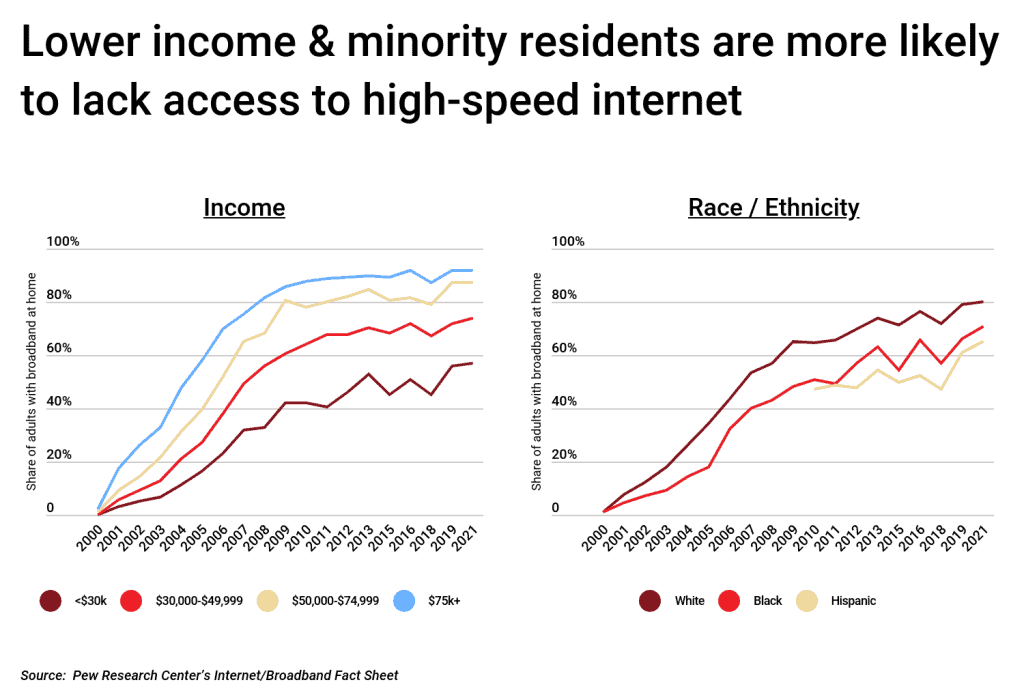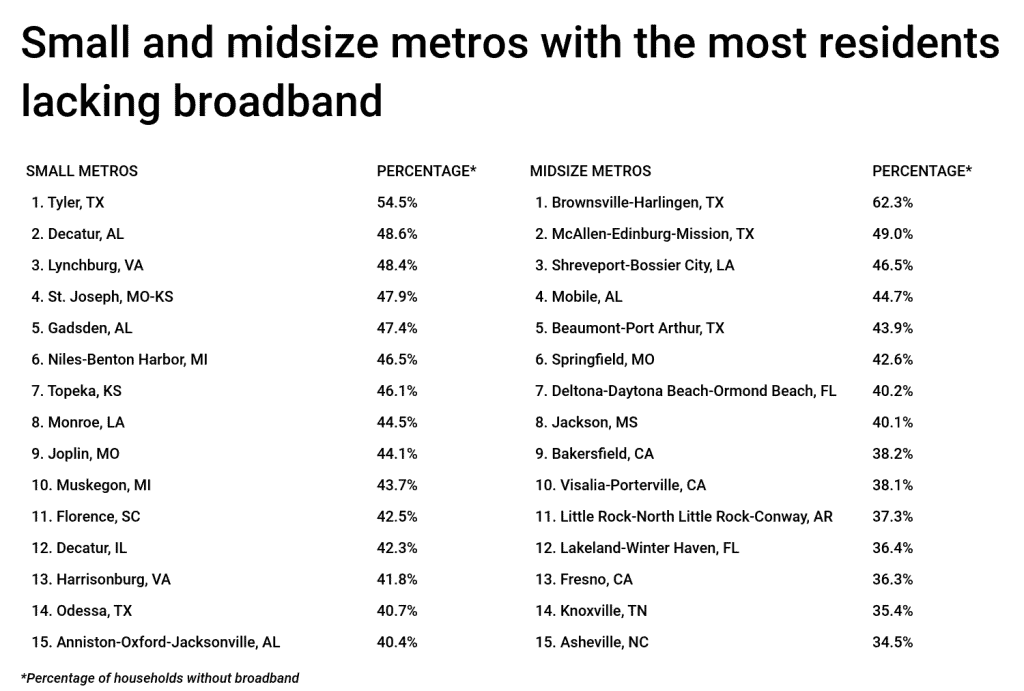Last November, I watched as President Joe Biden signed into law a $1.2 trillion infrastructure bill. As someone who follows American politics closely, I recognized this as one of the largest federal spending packages in history and a cornerstone of Biden’s domestic agenda.
The bipartisan bill includes billions of dollars in investment for infrastructure priorities like roads, bridges, and water and sewer systems. But one of the most significant items in the new bill is a $65 billion allocation to improve access and affordability for broadband internet.
Broadband advocates have been arguing for expanded access to high-speed internet for years. These advocates note that internet access is critical for participating in the modern economy. But many households and communities are unable to secure reliable internet service.
Table Of Contents
Broadband Access Throughout the US
In 2019, the Federal Communications Commission estimated that 21 million Americans lacked access to broadband internet. Others have placed the figure far higher than that. And even in communities where broadband is available, some lower-income households cannot afford the cost of service.
But the COVID-19 pandemic may have been the catalyst to push universal broadband forward as a policy priority. Millions of American households transitioned to working and schooling from home during the pandemic. But a lack of reliable internet service left some workers unable to participate in the economy. And it deprived students of classroom instruction time.
This lack of access has disproportionately affected some communities more than others. Broadband access is highly correlated to a variety of demographic and economic factors, particularly income and race.
Demographic Factors Related to Broadband Availability
Data from the Pew Research Center shows that as of 2021, 92% of adults making greater than $75,000 per year had access to high-speed internet, compared to just 57% of those who earned less than $30,000 per year.
The situation is also bad along the lines of race and ethnicity. Fully 80% of white adults have reliable high-speed internet access, compared to just 71% of Black adults and 65% of Hispanic adults.

Geography
The demographic distribution of broadband access is also closely related to geography. Rural areas lag far behind urban and suburban communities in access to reliable high-speed internet.
What’s more, the rural areas most likely to lack high-speed internet access are those with higher populations of racial and ethnic minorities and lower income levels.
At the metro level, many economically distressed communities in the South and the Rust Belt region are among the least likely to have high-speed internet available.

DID YOU KNOW?
Hulu — unlike most streaming providers — allows you to watch on-demand programs ad-free. It also allows you to fast-forward commercials on pre-recorded shows and sporting events on your cloud DVR. Read more about Hulu in our complete Hulu + Live TV review.
Data
The data used in this study is from the U.S. Census Bureau’s 2019 American Community Survey. To identify the locations with the most residents lacking high-speed internet, researchers at HotDog.com calculated the share of households without access to broadband internet service such as cable, fiber optic, or DSL installed in the household. In the event of a tie, the location with the greater percentage of residents lacking any internet access was ranked above.
Researchers also calculated the percentage of households whose only way to access the internet is through a cellular data plan, median household income, and the poverty rate. For details, see our methodology below.
Here are the metropolitan areas with the most residents lacking high-speed internet.

Large Metros With the Most Residents Lacking Broadband
15. Rochester, NY
- Percentage of households without broadband: 28.0%
- Percentage of households without any internet access: 10.9%
- Percentage of households with cellular data only: 10.6%
- Median household income: $61,000
- Poverty rate: 12.4%
TRENDING
For sports fans, FuboTV may be the best alternative to cable. With it, you can get everything you currently get from a cable provider and spend less while doing it. For more info on FuboTV, be sure to check out this comprehensive FuboTV review.
14. Jacksonville, FL
- Percentage of households without broadband: 28.2%
- Percentage of households without any internet access: 7.7%
- Percentage of households with cellular data only: 13.8%
- Median household income: $64,800
- Poverty rate: 11.5%
13. Miami-Fort Lauderdale-West Palm Beach, FL
- Percentage of households without broadband: 28.3%
- Percentage of households without any internet access: 11.6%
- Percentage of households with cellular data only: 10.3%
- Median household income: $59,500
- Poverty rate: 13.5%
12. St Louis, MO-IL
- Percentage of households without broadband: 28.7%
- Percentage of households without any internet access: 10.3%
- Percentage of households with cellular data only: 11.0%
- Median household income: $65,000
- Poverty rate: 9.9%
11. Buffalo-Cheektowaga-Niagara Falls, NY
- Percentage of households without broadband: 28.7%
- Percentage of households without any internet access: 11.0%
- Percentage of households with cellular data only: 11.6%
- Median household income: $58,800
- Poverty rate: 13.1%
10. Indianapolis-Carmel-Anderson, IN
- Percentage of households without broadband: 29.0%
- Percentage of households without any internet access: 11.4%
- Percentage of households with cellular data only: 11.4%
- Median household income: $62,000
- Poverty rate: 10.5%
9. Richmond, VA
- Percentage of households without broadband: 29.7%
- Percentage of households without any internet access: 12.9%
- Percentage of households with cellular data only: 10.8%
- Median household income: $67,800
- Poverty rate: 10.0%
8. San Antonio-New Braunfels, TX
- Percentage of households without broadband: 29.8%
- Percentage of households without any internet access: 10.8%
- Percentage of households with cellular data only: 11.5%
- Median household income: $60,600
- Poverty rate: 13.5%
7. Tucson, AZ
- Percentage of households without broadband: 30.5%
- Percentage of households without any internet access: 9.6%
- Percentage of households with cellular data only: 12.7%
- Median household income: $55,980
- Poverty rate: 13.8%
6. Cleveland-Elyria, OH
- Percentage of households without broadband: 30.6%
- Percentage of households without any internet access: 14.7%
- Percentage of households with cellular data only: 8.7%
- Median household income: $55,760
- Poverty rate: 13.5%
5. New Orleans-Metairie, LA
- Percentage of households without broadband: 32.6%
- Percentage of households without any internet access: 14.0%
- Percentage of households with cellular data only: 12.1%
- Median household income: $55,000
- Poverty rate: 16.4%
4. Louisville/Jefferson County, KY-IN
- Percentage of households without broadband: 33.4%
- Percentage of households without any internet access: 12.7%
- Percentage of households with cellular data only: 14.6%
- Median household income: $60,400
- Poverty rate: 11.9%
3. Oklahoma City, OK
- Percentage of households without broadband: 34.3%
- Percentage of households without any internet access: 10.1%
- Percentage of households with cellular data only: 16.1%
- Median household income: $60,000
- Poverty rate: 13.1%
2. Memphis, TN-MS-AR
- Percentage of households without broadband: 36.8%
- Percentage of households without any internet access: 16.9%
- Percentage of households with cellular data only: 11.4%
- Median household income: $54,500
- Poverty rate: 15.4%
1. Birmingham-Hoover, AL
- Percentage of households without broadband: 37.0%
- Percentage of households without any internet access: 12.5%
- Percentage of households with cellular data only: 16.4%
- Median household income: $57,100
- Poverty rate: 14.0%
Methodology
The data used in this study is from the US Census Bureau’s 2019 American Community Survey 1-Year Estimates and Pew Research Center’s Internet/Broadband Fact Sheet.
To identify the locations with the most residents lacking high-speed internet, researchers calculated the share of households without broadband internet service such as cable, fiber optic, or DSL installed in the household. In the event of a tie, the location with the greater percentage of residents lacking any internet access was ranked above.
Researchers also calculated the percentage of households whose only way to access the internet is through a cellular data plan, median household income, and the poverty rate. For a detailed overview of the internet-related variables from the US Census Bureau, see the American Community Survey.
Only locations with at least 100,000 residents were included in the analysis. Additionally, locations were grouped based on population size:
- Small (100,000–349,999)
- Midsize (350,000–999,999)
- Large (1,000,000+).
Detailed Findings
Page Updates ▼▲
-
Image changes. Reformatting. Reworded some things.
-
Added new section. Added sub-section. Image changes. Updated some sub-sections. Updated some section headings.
- How to Watch Pac-12 College Teams This Year - 08/06/2024
- States That Have Produced Leading Actors and Actresses - 09/06/2022
- US States With the Fastest Internet - 06/21/2022

Leave a Comment